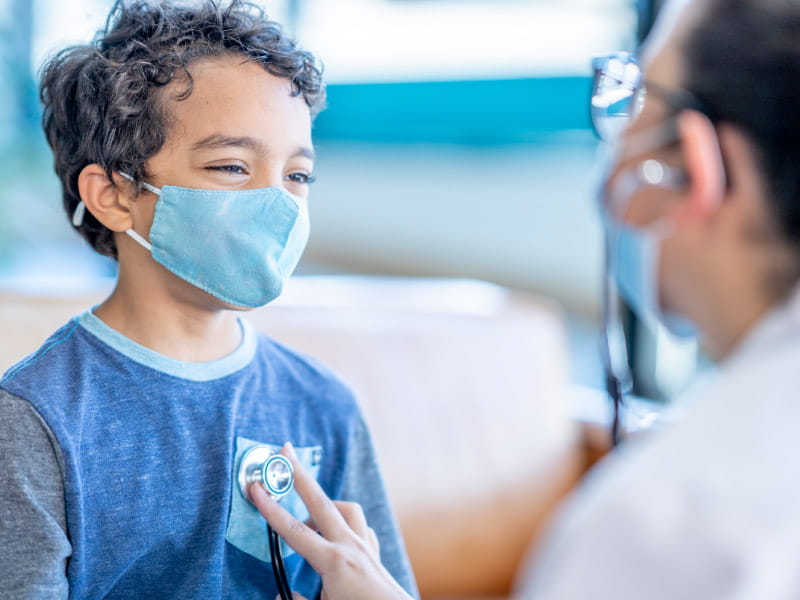
DiYES International School – Children and COVID-19 have been a contentious subject since the beginning of the pandemic. From the early days of lockdowns and school closures to ongoing concerns about long-term health effects, discussions about the virus’s impact on children have often sparked debate. As we look ahead to 2025, it’s clear that children’s experiences with COVID-19 have been multifaceted, and the consequences of the virus continue to shape their lives in both seen and unseen ways. However, much has changed over the last few years, with vaccinations, increased immunity, and better knowledge of the virus reducing risks for younger populations.
From the beginning of the pandemic, we have known that COVID-19’s risk is strongly correlated with age. Older adults have consistently been at the highest risk for severe illness, while younger populations, especially children, have had a lower chance of experiencing serious complications. In fact, studies show that children, particularly those between 1 and 10 years old, are at a much lower risk of severe illness from COVID-19 compared to adults. The rate of ICU admissions for COVID-19 in children is substantially lower than that of influenza.
In 2025, as children over the age of 2 are likely to have had at least one COVID-19 infection, immunity has played a critical role in reducing their likelihood of experiencing severe illness if infected again. This is not to say that parents should be careless, but the risk has shifted. For most children, COVID-19 now poses a comparable risk to other common childhood illnesses like seasonal influenza or RSV.
“Read about: Successful Guide to Boosting Your Child’s Height: Tips for Parents”
Long COVID has been one of the major concerns regarding the pandemic, especially for those who have experienced severe illness. However, data suggests that the risk of Long COVID in children is much lower than in adults. A significant study from the UK, the REACT study, found that only about 3% of children who had mild COVID-19 infections went on to develop long-term symptoms. These symptoms were often mild, and many children recovered fully within a few months.
Another large-scale study in Israel, which followed nearly 2 million children, found that those who were not hospitalized for COVID-19 had minimal long-term symptoms. The risk of Long COVID was incredibly low in this group, further confirming that children’s acute cases of COVID-19 are less likely to result in lasting health issues.
While Long COVID remains a concern for some children, especially those who had more severe infections, the overall risks are lower compared to those seen in adults. Parents of children who had mild cases should feel reassured that their child is unlikely to experience significant long-term effects from the virus.
Disability often raises a specific concern when discussing the effects of COVID-19 on children. With approximately 1 in 10 children under 18 living with some form of disability, experts have debated the question of increased vulnerability. However, disability is not a single factor when it comes to the risk of infectious diseases. The impact of a child’s disability on their immune system varies greatly depending on the nature of the disability itself.
Research from the UK shows that while certain disabilities, such as chronic respiratory diseases, increase the risk of severe outcomes from COVID-19, other conditions, like hearing or vision impairment, have only a minor impact on the overall risk. Therefore, the risks to children with disabilities are often similar to those faced by children without disabilities, though some vulnerable children may face higher risks depending on their specific medical needs.
“Read more: The Age of 3: Is It Necessary to Attend Preschool?”
One of the most common concerns among parents and public health experts alike is whether repeat COVID-19 infections will continue to pose a risk to children. With many children having had at least one infection by 2025, the risk from reinfection is significantly lower than it was in the early days of the pandemic. Immunity, whether acquired through vaccination or prior infection, plays a crucial role in mitigating the severity of subsequent infections.
In fact, studies have shown that the risk of severe outcomes from repeat infections is much lower than from an initial infection. Even if children face multiple exposures to the virus, their previous infections and immunity reduce the likelihood of experiencing serious illness, Long COVID, or requiring hospitalization.
While COVID-19 remains a public health challenge, the overall impact on children is much less concerning in 2025 than it was in the early days of the pandemic. Vaccination efforts, increased immunity, and the natural course of the virus have all contributed to a lower risk for children, with most now having had at least one exposure to the virus.
Parents may still worry about COVID-19, but it’s important to put the disease in perspective. Other illnesses, such as influenza and RSV, continue to pose risks to children, and most experts agree that the overall risk of COVID-19 is now similar to that of these more common illnesses. Moving forward, the focus should be on maintaining good hygiene practices, supporting immunity through vaccination, and creating environments that minimize the risk of any infectious disease.
Ultimately, while the pandemic has been a challenging time for families, the data suggests that children in 2025 are in a much safer position with regard to COVID-19 than they were at the height of the crisis. And for parents, this is a reminder that there is hope, resilience, and recovery ahead as we continue navigating the post-pandemic world.